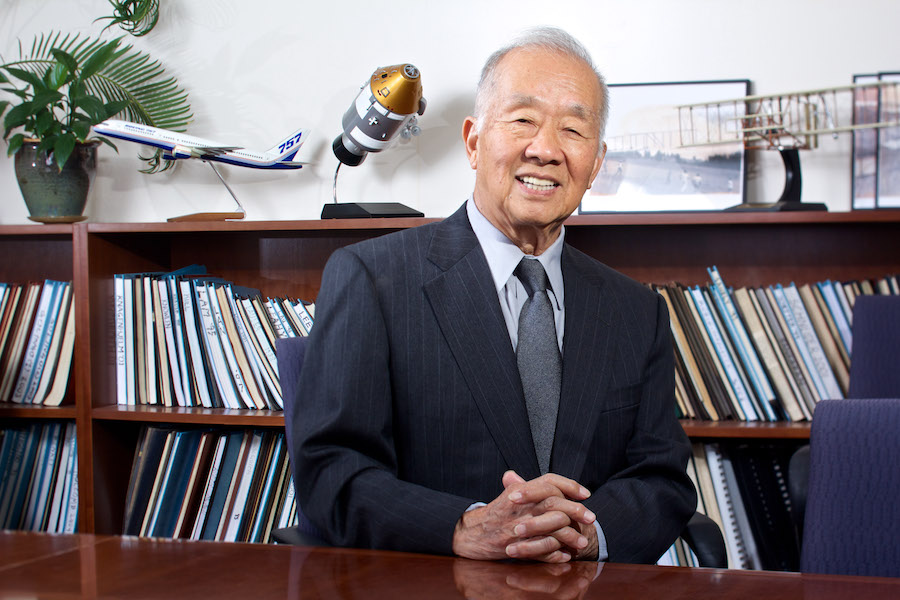Amy Sprague
July 6, 2023
As Professor Mitsuru Kurosaka retires, A&A’s Amy Sprague interviewed him on his research focuses and inspirations over the years and his A&A career that started in 1987.

Professor Mitsuru Kurosaka
Your research contributed to the fundamental understanding of vortices, which is crucial in the design and operation of gas turbines. Can you distill your findings for us?
With my former student Brenda Haven, we predicted and demonstrated the effectiveness of vortical cooling. Brenda is now teaching at Embry Riddle University. Vortical cooling is a technique that intentionally induces vortices to transfer heat from a blade surface to the surrounding fluid. The advantage of this technique is that it does not rely on higher airflows. The efficacy comes by manipulating flow patterns. Our results have led to improvements in the design of various gas turbines. As a side note, it is gratifying to add that recently Brenda co-authored a well-known textbook on gas turbine design concept.
With my former students C. B. Cain and Jeremy Wimer, both later rising to the rank of colonel in the Air Force, and with contributions from others, we provided a definitive explanation for the formation of vortex breakdown, a sudden enlargement of flow in delta wings. Understanding vortex breakdown is also crucial for optimizing the design and performance of gas turbine combustors, which rely on swirling flows.
You are also well-known for your long-time research on detonation engines. Where do you see that technology taking us?
The detonation engine has been quite interesting because, despite its apparent simplicity, it has a complex interplay of gas dynamics and chemistry. I had made several predictions which former students Jake Boening and James Koch confirmed.
Although the technology may not be used for launching large payloads, it’s lightweight and compact, which makes it ideally suited for deep space propulsion and spacecraft attitude control.
What have been your greatest inspirations?
The most rewarding inspirational experience was my education at CalTech. There were clusters of accomplished researchers who delivered meticulously-prepared class lectures, which started from the highest vantage point and penetrated deeper with insight, ending in denouement—it was like watching the panoramic view of the Grand Canyon, so awe inspiring. It was a refreshing, radical departure from the memory-based rote system of Japan where I had come from.
Also, before I started my academic career, I was an engineer at the General Electric R&D Center in Schenectady, New York, now called GE Research. Instead of being pigeon-holed in one particular area, I was exposed to different research topics related to a wide variety of GE products such as jet engines, nuclear reactors, power generating steam turbines , torpedoes and more. My mission there was to solve industrial problems, but I was reminded again and again of the importance of the fundamental perspective I had internalized at CalTech.
For instance, there was an annoying noise problem in the high bypass turbofan engines, called the multiple pure tones. I theorized its source as the aerodynamic interference between shock waves emanating from fan blades and expansion waves, which I learned at CalTech. The calculated noise field convincingly matched with the key observed features. Other engine manufacturers such as Rolls Royce and Pratt-Whitney publicly accepted my theory, which was unusual.
What sticks with you the most of your years at the UW?
It is definitely teaching. I have received many kind comments from the alumni working in industry and the military, which is so rewarding. Many have communicated that their exposure to airbreathing propulsion in my lectures was valuable to their careers. It was indeed a privilege to be given an opportunity to mold so many young minds. This was in no way one-sided. Students with their fresh and unfettered perspectives asked many out-of-box questions, which helped me to deepen my own understanding–a very fulfilling and lasting experience indeed.
Do you have any last words for A&A?
I would like to leave you with a phrase from the poem “To ----“ by 18th century British poet Percy Bysshe Shelly which refers to the burning desire of the tiny moth to reach a higher ground: “The desire of the moth for the star.”
Onward and upward!